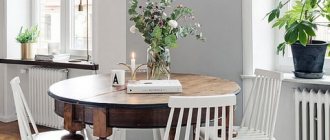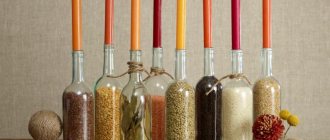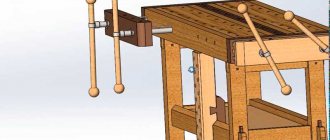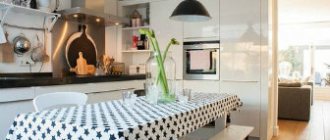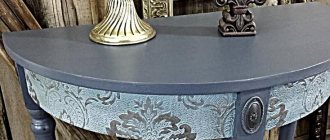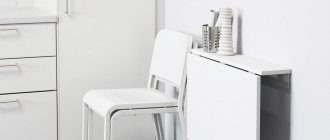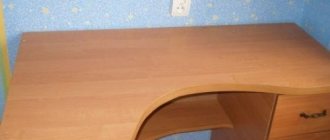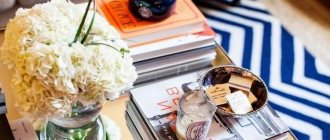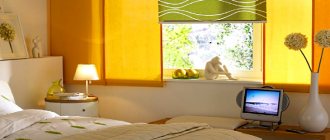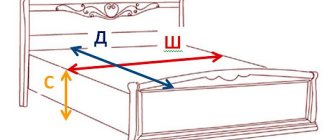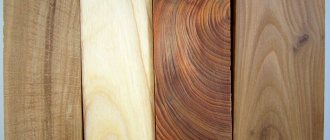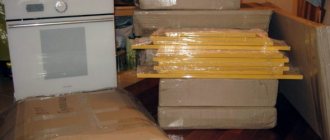How to sew a tablecloth - instructions
In order for a novice seamstress to sew a tablecloth correctly, you need to follow some rules and instructions. It is important to make the pattern correctly so that the item does not look small or crooked. To do this, careful measurements are taken. Here we will talk about all kinds of materials that are used to sew this product and about the features of its creation.
Even if it is a small home feast or just a family dinner, then a woven covering will create a special atmosphere and festive mood.
Colors
Light colors have been and remain the most popular - they always look elegant. Such tablecloths will be appropriate for any occasion, be it a regular family dinner or a special event. But with more saturated shades, you need to choose the right tactics, dividing them into cold and warm colors:
Try to buy tablecloths without multi-colored patterns - colorful products are more suitable for a children's sweet table or tea party in the country. Otherwise, plain fabrics would be more appropriate. And to create a beautiful combination of colors, you can simply use multi-layer styling or bright paths.
And most importantly, the tablecloth should be in harmony with the surrounding interior. Whether it will blend in with it or attract attention with contrasting colors is up to you. As a last resort, you can order or sew chair covers from the same fabric from which the tablecloth is made. You can easily find photos and patterns on the forums of craftswomen. Then your dining room will have a full-fledged dining group, made in the same style.
Design
The design of the tablecloth can be completely different and it should depend on the overall style of the room where the table is located. The first way to change or create a design is through decoration. There are a lot of options - lace, embroidery, applique, edging. It all depends on the imagination of the needlewoman.
What do you need for sewing?
Knowing the basics of sewing, it will be easy to make an oval tablecloth.
To do this you will need:
- tailor's scissors;
- textile;
- tracing paper for patterns;
- pencil, chalk or soap;
- ruler, measuring tape;
- pins;
- thread with needle;
- sewing machine;
- decorative elements: lace, fringe.
Selection of tools and material
Before you begin, you need to prepare all the necessary materials and tools that will be useful in the sewing process. Here is the list:
- The fabric from which the base will be sewn.
- Materials for edging - ribbons, lace, and other additional decorations.
- Sewing machine.
- Threads of different colors, needles, scissors, a centimeter and a piece of chalk.
The materials for a handmade tablecloth can be completely different. They can be divided into two groups - everyday and holiday options.
A beautiful and fashionable tablecloth on the kitchen table sets the overall mood in the room.
Everyday options include:
- Oilcloth. This is the most budget-friendly and easy-to-maintain option.
- Polyester. It is also a fairly cheap material that is easy to wash and does not need to be ironed after washing.
- Jacquard. Typically, such models have a double-sided pattern, so it can be changed to suit your mood.
If we talk about more festive options, they are usually used to cover the living room table, as well as when guests come.
More and more modern designers insist that a kitchen interior is incomplete without a beautiful tablecloth.
From curtain fabric
Curtain fabric, as the name suggests, is used for sewing curtains, but it also makes beautiful tablecloths. Such interior elements are very dense, durable and quite easy to wash.
Curtain fabrics are any materials that are used to sew thick curtains.
Made from linen
This is an incredibly delicate material that will decorate any table. Linen fabric usually has different patterns on it and is strong and dense. But to protect it from contamination, special stands or coverings are usually placed on top.
Linen is a soft, durable, environmentally friendly material. The fabric is applicable in interior design and is suitable for making home textiles.
Cotton
Natural cotton tablecloths are usually coated with Teflon or acrylic coatings, so they can withstand frequent washing. These coatings protect delicate fabrics from spills and stains. But at the same time, the fabric looks quite light and airy.
Cotton fabrics are practical, beautiful, and varied.
Silks
This is a fairly expensive material, so a tablecloth made from it will be of particular value. Silk can also be used to make covers for bedside tables or chests of drawers.
Silk is a valuable fabric that is known throughout the world for its soft shine, unique smoothness and high strength.
Whatever fabric the seamstress chooses for her product, it is important to follow some rules for working with this particular material in order to get the finished item as quickly and easily as possible.
Criterias of choice
The choice of tablecloth covering directly depends on the interior of the room and on the quality in which it will be used. Of course, you can buy a classic plain tablecloth in light shades - this is a win-win option, equally suitable for almost any style. But if you want originality, then, in addition to the main criteria, you will have to take into account other individual aspects.
It is necessary to determine:
- right size;
- appointment;
- degree of practicality;
- color;
- style.
The color scheme can be very diverse, but the best effect is achieved when the tablecloth is matched to match the rest of the textiles, for example, towels, curtains, seat upholstery or chair cushions. In addition, you should avoid too bright designs and large patterns - the dining area should promote calm eating and not irritate with excessive colors.
The exception is the option when the entire interior of the room is designed in the same tone and there is a need to somehow diversify it. In this case, a tablecloth can become an appropriate accent.
Features of cutting and sewing tablecloths
Tables can have completely different shapes, so the tablecloths must match them. The pattern is made taking into account the size and shape of the table and has the following sequence:
- First you need to decide on the amount of fabric needed. To do this, measure the height of the table (from the floor to the edge of the tabletop) and the diameter of the tabletop itself. Then you need to add up the three measurements and get the fabric consumption. You must remember to allow for seams and hem allowances so that the product does not turn out too short.
- Next you will need to cut the fabric. It is necessary to cut the fabric in half, and one of the parts in half again. Then they are sewn together according to the pattern. The result should be a square, which will then turn into a circle.
- It is necessary to apply a special technique to ensure that the circle is perfectly even.
- Next, the edges are processed so that they do not crumble in the future. The hems should be hemmed using a sewing machine and the finished item should be ironed to straighten all the seams.
The shape of the tabletop and its size determine how much fabric we need to buy for cutting.
Important! When using cotton fabric, before sewing a tablecloth from it, you need to wash and iron it. This is done in order to avoid shrinkage of the finished product.
On a rectangular table
To sew a perfectly flat tablecloth on a rectangular table with your own hands, you need to correctly calculate the material consumption. The rectangular table is most often used in homes, so there are a lot of recommendations for calculations. For this shape, you need to measure the length and width of the tabletop, and then add double the required allowance to each number.
A rectangular table can only be covered with tablecloths of the same geometry.
Round
A round table is very often placed in living rooms and just in the kitchen, because it looks quite elegant and cute. In order for the tablecloth to look appropriate enough on it, you need to measure the diameter of the tabletop, and also add an allowance to this figure, which you first multiply by two.
Both square and round tablecloths look beautiful on round tables.
Oval
An oval table usually takes up a lot of space, so it needs a large room. But if there is such a table in the house, then its owner will definitely be interested in how to sew a beautiful tablecloth on an oval table with her own hands for beginners. First, you need to measure the largest and smallest diameters of the tabletop and add to both values the length of the edges that will hang, multiplied by two.
For an oval table, you can make a tablecloth in the shape of an ellipse or a rectangle.
To square
The square table is very compact, but most commonly used for small kitchens. For such a table, the measurements are carried out approximately the same as for a rectangular one.
To add style, two square tablecloths laid crosswise are sometimes used.
Edge processing and decoration
It is very important to properly process the edges of the tablecloth so that the product looks beautiful on both sides and lasts a long time.
To do this, we place the fabric with the wrong side facing us and begin to bend the edges 1 cm, while fixing them with special pins. Iron it thoroughly. After this, we fold it again and baste it.
Next, we sew the edges on a sewing machine, not forgetting to pull out the pins as we go.
A festive tablecloth can be decorated with various decorative elements:
Source
Tablecloth decor
To make the tablecloth look as unique and unusual as possible, after it is sewn, you need to make some kind of decor. To do this, you can read different ideas, come up with something yourself, or ask your friends. Here you will have to use your imagination, but this is the most interesting part of the whole process.
Edging with another fabric
For this type of decor, use any other fabric that will look harmonious with the color of the product itself. Pieces of fabric are cut to the required size and hemmed on the inside. The joints can be additionally trimmed with lace or satin.
To make your product look neat and beautiful, you need to decorate the edge.
Lace decoration
This is the most commonly used and most attractive way to decorate a tablecloth. First, a satin ribbon is sewn to the edge, after which a lace trim is sewn over the ribbon. You need to start stitching the ribbon from one of the corners, carefully making sure that it is sewn evenly and gathers into folds.
If you plan to trim the fabric with lace, you need to take this into account in your calculations. Otherwise, the hanging part will be too large.
Embroidery
Embroidery is a rather painstaking decoration that will require a lot of time. You can embroider a pattern on a piece of fabric, from which you can then sew a tablecloth, or you can make a pattern on a finished product.
To ensure that the product lies flat and does not bristle with unsightly folds, we recommend adding weight to the edge of the fabric.
Application
Appliques will certainly give the tablecloth a special and unique appearance, but you will also have to tinker with them a little. To do this, pieces of fabric of different colors are taken, from which individual elements are cut out and sewn together to create a specific picture. This picture is then sewn onto the required place on the canvas.
You can also make a pattern around the entire perimeter of the tablecloth, because it will look very attractive.
Decorating is the most interesting activity after the tablecloth is ready. At this stage, you can experiment to your heart’s content and create something that your guests will admire.
Decorating tips
Decorating a tablecloth involves a variety of options. The choice of decor is completely individual, although it must still match the style and design of the kitchen space.
Decoration methods:
- Braid, satin ribbons, edging. These options are well suited for an everyday cotton tablecloth.
- Lace and flounces add airiness and softness to the lines.
- Embroidery is a win-win option for any fabric, but it gives linen models a special elegance.
- Appliques, sequins, beads, buttons - such decor should be combined with the design of other kitchen textiles (curtains, towels).
- Fringe. Suitable for decorating heavy, dense fabrics, such as jacquard.
Thematic appliqués (for example, New Year's) placed along the edge of the canvas will make the table more festive and elegant and will definitely appeal not only to children, but also to adults.
You can decorate and enliven a dull tablecloth with the help of additional accessories, for example, runners (serving paths), coasters for plates or napkins. There can be either several narrow runners (in this case they should hang down) or one large one across the entire table. Narrow runners serve as a substitute for plate stands and are placed one for each person present at the table.
Plate stands can be made from almost any material - fabric, cork, silicone, plastic. It is important here that they stand out against the background of the tablecloth, but at the same time fit into the overall composition and harmonize with it.
Regardless of which decoration method is chosen, the main thing is that it matches the style direction of the kitchen interior. If you manage to achieve a harmonious combination, the created atmosphere will delight not only the owners, but also dear guests for a long time.
Pros and cons of a homemade tablecloth
A homemade tablecloth for the home has both pros and cons. The positive aspects of this thing include:
- The opportunity to do handicrafts and make things yourself.
- There are many options in the store, but this is a great opportunity to sew a product solely to your taste.
- Fabric costs much less than ready-made goods, so you can save a lot of money.
If we talk about the disadvantages, they are:
- The thing may not turn out quite beautiful, but it all depends on the abilities and desires of the needlewoman.
- If you want to make a special decor, then you will have to spend a lot of time on it. But for many it is even a pleasure.
Only those women who love this activity will take on such work, so everything should work out very well for them.
Only professionals can quickly sew and decorate a tablecloth. But beginners are advised to approach their work with all responsibility in order to make a beautiful, high-quality thing that will last as long as possible.
We try to quickly and easily crochet an openwork tablecloth
Tablecloths crocheted using various techniques are very popular.
One of the most stylish and easy-to-make models is an openwork tablecloth with “pineapples”. You can easily knit it in a few evenings. Required materials and equipment:
- thin cotton threads in white or any other color;
- hook No. 2.5 or No. 3.
Operating procedure.
Round tablecloths always start knitting from the center. Using a crochet hook, we collect a chain of 5 air loops and close it into a ring. We tie it as follows: we make 3 lifting loops, two loops to form an arch, then we alternate double crochets and two chain loops. There should be a total of seven double crochets in the first row. We tie the second row with 23 double crochets, having previously cast on 3 loops for lifting.
Next, we knit an openwork pattern according to the pattern below.
Thus we continue knitting up to the 28th row inclusive. Patterns of pineapples made from air loops are repeated in the center of the tablecloth and along its edges. Starting from the 29th row, we switch to knitting according to the following pattern. Here, a large mesh alternates with a picot of double crochets and long chains of air loops, due to which a high delicacy of the product is achieved. In the 35th row, the bases of future “pineapples” are formed.
In the 48th row, the binding is performed: arches of 5 air loops, double crochet and picot alternate. If desired, the tablecloth binding can be made less openwork by replacing it with a row of single crochets.
At the end of the work, we cut and thread the thread, wash and steam the tablecloth. The product can be starched, decorated with tassels or fringe. The openwork tablecloth is ready! It is ideal for a round table in the living room.
